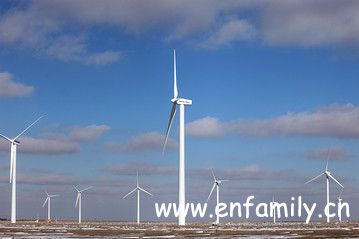
中国甘肃省的风电机组
“大风吹袭,让你充满幻想,或让你头疼。”用俄国凯瑟琳大帝(Catherine the Great)的话用来形容中国风力涡轮制造商的融资之路真是再恰当不过了。根据Dow Jones Investment Banker的报道,让他们头疼会更有可能。
'A great wind is blowing, and that gives you either imagination or a headache.' Catherine the Great surely was referring to capital raising for China's wind turbine makers. As Dow Jones Investment Banker reports, for them, a headache is more likely.
据全球风能协会(Global Wind Energy Council)数据显示,去年中国成为全球最大的风能市场,年装机容量130亿瓦特,年景不错。
Last year was a good time for China when it became the largest wind market by annual installed capacity at 13 gigawatts, according to the Global Wind Energy Council.
不幸的是,去年的增长预示中国涡轮生产商产能过剩,表明在2009年的过度扩张之后一些小型生产商将被淘汰出局。长期来看,这当然对幸存者有利。
Unfortunately that growth heralds overcapacity for Chinese turbine makers, suggesting a shake-out for some smaller names after 2009's aggressive build out. That should, of course, play to survivors' advantage in the long-term.
与此同时,对于那些据报道欲在香港上市的风电运营商们而言,其经济前景可能会更好,虽然近期的首次公开募股(IPO)市场状况不佳。
Meanwhile, for the clutch of wind-farm operators reportedly toying with a Hong Kong listing, the business outlook is probably better, though the recent IPO market hasn't been forgiving.
中国风电行业得益于过去五年顺风顺水的环境和优惠政策。例如,风电的上网电价比煤电高让风电运营商获益良多,而按购买价值计算涡轮部件国产化率不得低于70%的规定也使本土部件生产商受益匪浅。
Favorable macro-tailwinds and preferential policy over the last five years have helped China's wind industry. For example, farm operators are aided by on-grid tariffs for wind being higher than fossil fuels', while local component-makers gain from rules ensuring at least 70% of turbine components by purchase value are made domestically.
2002-2008年,中国发电量的复合年增长率为12.8%,高于同期实质国内生产总值10.5%的复合年增长率。
And in the seven years to 2008 electricity generation grew at a compound annual growth rate of 12.8%, eclipsing China's real GDP CAGR of 10.5% over the period.
坏消息呢?
And the bad news?
首先,新参与者大量涌入时,友好的市场份额规则不会形成对利润的支持。
First: friendly market-share rules don't translate into supporting margins when new entrants flood in.
例如,2005年之前涡轮制造商仅有六家,现在增加到70家。中国涡轮制造商销售三强之一──新疆金风科技股份有限公司的EBIT (扣除利息及税项前盈利)利润从2006年的21.5%下降到去年的16.7%。
Turbine makers, for example, have increased from six before 2005 to around 70 today. Meanwhile Xinjiang Goldwind Science & Technology Co. Ltd., one of the country's top three turbine manufacturers by sales, saw its Ebit margins decline to 16.7% last year against 21.5% in 2006.
规模更小的未上市公司很可能也有相似的经历,但鉴于它们的营运杠杆更高,其利润将更低。
Smaller, unlisted firms likely experienced a similar trend, aggravated by lower margins given their higher operating leverage.
由于风电场需要更大尺寸的涡轮,制造商们被迫在一个已经高度竞争的市场中投入资本进行新的生产和研发。
With farms shifting toward larger turbine sizes manufacturers are being pushed into capital expenditure for new production and research and development in an already highly competitive market.
此外,大型风电运营商青睐有着良好历史表现的供应商,它们能够提供更大型、成熟的全套装备。中国龙源电力集团公司是中国装机容量最大的风电运营商,去年6月末,其涡轮产能的四分之三来自Gamesa公司和金风公司。这意味着中国本土的部件行业将重新洗牌,特别是那些二线制造商。对于上市和融资而言不是什么太好的消息,但竞争的减少应当有利于幸存者利润的增长。
Additionally, big farm operators gravitate to suppliers with a performance history, which favors larger, established outfits. China Longyuan Power Group Corp.--China's largest wind-farm operator by capacity--sourced three-quarters of its turbine capacity from Gamesa and Goldwind at the end of June last year. This implies the domestic component sector is primed for realignment, especially among the second-tier makers. That isn't a great backdrop for listings or capital raising but survivors' margins should benefit from less competition.
鉴于风电运营商──中国华能集团公司和中国大唐集团公司的可再生电力业务的盈利前景比涡轮制造商高,或许有更好的前景。
Wind farm operators--China Huaneng Group and China Datang Corp,'s renewable power unit--may have better prospects given superior earnings visibility over turbine assemblers.
龙源公司去年12月在香港上市以来的表现比摩根士丹利中国指数(MSCI China index)高5.9%,虽有些不稳定,但仍使其成为自12月以来香港最成功的IPO项目。
Longyuan floated in Hong Kong in December. It has outperformed the MSCI China index by 5.9% since debuting--yes, with a somewhat erratic trajectory--making it one of Hong Kong's more successful IPOs since December.
过去六个月,可再生能源电力供应商──中国风电集团有限公司和中国电力新能源发展有限公司的综合指数比摩根士丹利中国指数高30%左右。
A composite index of renewable energy power providers China Windpower Group Ltd. and China Power New Energy Development Co. has outperformed the MSCI China by about 30% over the past six months.
然而,与大多数亚洲市场形成鲜明对比,中国内地和香港股市自1月以来出现了负回报,且近期流入中国股市的外资一直不多,凸显此地的IPO环境更为艰难。
However, in contrast with most of Asia, both mainland and Hong Kong equity markets have logged negative returns since January and foreign fund flows into Chinese equity markets have been poor lately, underscoring the tougher environment for IPOs there.
此外,行业观察人士称50兆瓦特电场的内部回报率约为10%,这听起来较为可信。但瑞信(Credit Suisse)的推测更为可信:一家50兆瓦特的风电场若通过股市融资40%,其股本回报率可能约为4-6%。
Moreover, internal rates of return for 50 megawatt farms are around 10%, industry observers say, which sounds respectable, until you read Credit Suisse's estimate that a 40%-equity financed 50MW Chinese wind farm probably generates a return on equity of some 4-6%.
通过杠杆作用,回报率可能有所提高,但随着中国货币和贷款政策趋紧,这样做可能不那么容易,对股票投资者而言吸引力也没那么大。
That could be juiced with leverage but, with Chinese monetary and lending policy tightening, that mightn't be so easy or appealing for equity investors.
因此,中国风电运营商要想让投资者相信现在押注风电正恰逢其时,可能还需要很多努力。
So Chinese wind farm operators may still have their work cut out convincing investors that now is the time to bet on wind. |
|